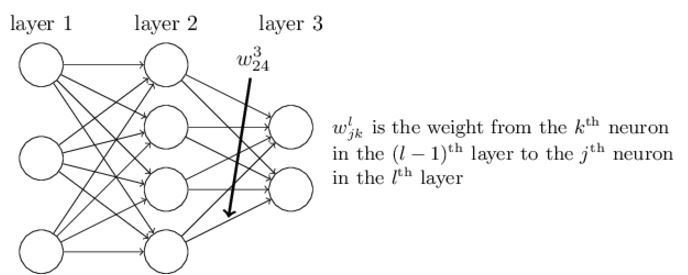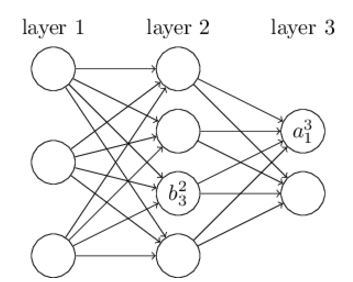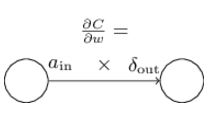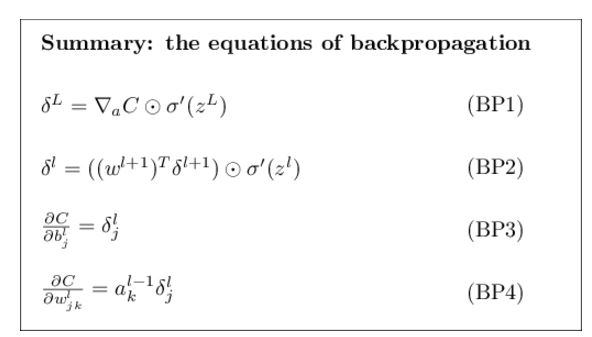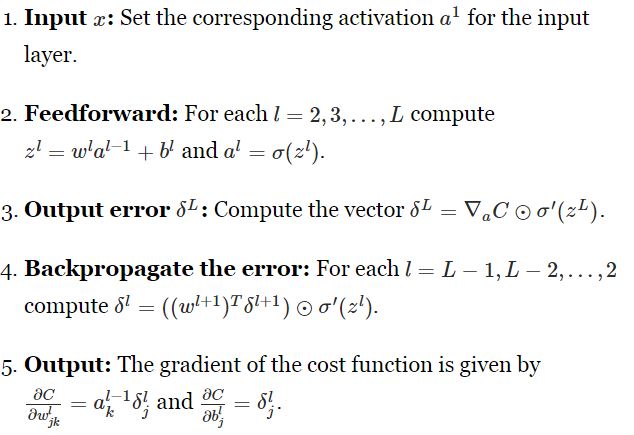上一周主要看了 Neural Networks and Deep Learning 网上在线课程的第二章的内容 和 斯坦福大学 《机器学习》的公开课,学习了BP( Back Propagation Algorithm, 反向传播算法)。现在总结如下:
只要使用神经网络就会用到BP算法,反向传播算法可以用来学习神经网络的权值,仍然采用梯度下降算法,以最小化网络的实际输出与目标输出之间的平方误差为目标。BP算法的目标是在神经网络中可以求任意权值w 和 偏置b 的成本函数(cost function)C 的两个偏导数——C对w的偏导数 和 C对b的偏导数
首先定义几个符号:
图1 
同样的,再定义 


由此,可以得到激励函数a的计算公式:
公式简写如下:

令 
。
在正式介绍BP算法之前,先介绍一种运算规则——Hadamard product(阿达马乘积)
定义 
根据公式 (23)、(29)可知,the error 是和C对w的偏导数 和 C对b的偏导数 有关。
现在给出BP算法使用的四个基本公式:
将(BP1)公式改写为矩阵形式的公式:
关于两层之间的delt计算公式:
关于偏置b 的BP公式:
上述公式简记为:
关于权值w 的BP公式:
上述公式简记为:
可以用下图来形象地表示上述关系式
有关上述四个公式的证明,这里就不再给出,如果感兴趣可以点击本文开头提供的网上在线课程的链接进行查看,主要就是运用了高数中的链式求导法则进行相关证明。
BP算法
BP(反向传播)算法提供了一种计算成本函数(cost function)梯度的方法。算法主要流程如下:
BP算法的代码实现
class Network(object):
...
def update_mini_batch(self, mini_batch, eta):
"""Update the network's weights and biases by applying
gradient descent using backpropagation to a single mini batch.
The "mini_batch" is a list of tuples "(x, y)", and "eta"
is the learning rate."""
nabla_b = [np.zeros(b.shape) for b in self.biases]
nabla_w = [np.zeros(w.shape) for w in self.weights]
for x, y in mini_batch:
delta_nabla_b, delta_nabla_w = self.backprop(x, y) #使用BP算法求解两个偏导数,进而可求成本函数的梯度
nabla_b = [nb+dnb for nb, dnb in zip(nabla_b, delta_nabla_b)]
nabla_w = [nw+dnw for nw, dnw in zip(nabla_w, delta_nabla_w)]
self.weights = [w-(eta/len(mini_batch))*nw
for w, nw in zip(self.weights, nabla_w)]
self.biases = [b-(eta/len(mini_batch))*nb
for b, nb in zip(self.biases, nabla_b)]反向传播算法的代码实现:
class Network(object):
...
def backprop(self, x, y):
"""Return a tuple "(nabla_b, nabla_w)" representing the
gradient for the cost function C_x. "nabla_b" and
"nabla_w" are layer-by-layer lists of numpy arrays, similar
to "self.biases" and "self.weights"."""
nabla_b = [np.zeros(b.shape) for b in self.biases]
nabla_w = [np.zeros(w.shape) for w in self.weights]
# feedforward
activation = x
activations = [x] # list to store all the activations, layer by layer
zs = [] # list to store all the z vectors, layer by layer
for b, w in zip(self.biases, self.weights):
z = np.dot(w, activation)+b
zs.append(z)
activation = sigmoid(z)
activations.append(activation)
# backward pass
delta = self.cost_derivative(activations[-1], y) * \
sigmoid_prime(zs[-1])
nabla_b[-1] = delta
nabla_w[-1] = np.dot(delta, activations[-2].transpose())
# Note that the variable l in the loop below is used a little
# differently to the notation in Chapter 2 of the book. Here,
# l = 1 means the last layer of neurons, l = 2 is the
# second-last layer, and so on. It's a renumbering of the
# scheme in the book, used here to take advantage of the fact
# that Python can use negative indices in lists.
for l in xrange(2, self.num_layers):
z = zs[-l]
sp = sigmoid_prime(z)
delta = np.dot(self.weights[-l+1].transpose(), delta) * sp
nabla_b[-l] = delta
nabla_w[-l] = np.dot(delta, activations[-l-1].transpose())
return (nabla_b, nabla_w)
...
def cost_derivative(self, output_activations, y):
"""Return the vector of partial derivatives \partial C_x /
\partial a for the output activations."""
return (output_activations-y)
def sigmoid(z):
"""The sigmoid function."""
return 1.0/(1.0+np.exp(-z))
def sigmoid_prime(z):
"""Derivative of the sigmoid function."""
return sigmoid(z)*(1-sigmoid(z))